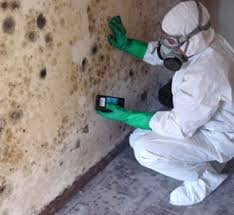Hey Everyone,
In this article I wanted to start a possible series about something that could be helpful to a lot of people. The subject is Black Mold.
First, I want to let everyone know that the information will be provided is from my personal experience with Black Mold working in Hazardous/Toxic environments.
Personal History with Black Mold

In 2013 to 2014, I was on a contract at Hunters Point District San Francisco and during a portion on that contract I assisted in the removal of black mold and other hazardous waste from abandoned buildings. A friend of mine informed me that my experience with Black Mold could be useful to other people and he convinced me to journal my experiences.
I have collect my notes, tips and personal experiences from working in environments with black mold from possibly one of the most hazardous locations in California.
The Importance of indoor Air Quality: Moisture
In any environment, including indoors, there’s always a percentage of water in the atmosphere. Outside this water accumulates and collects into clouds, mist and fog. Inside it does the same exact action. Only there isn’t enough air particles for the airborne water to attach onto inside. So it does the next best thing. Finds a slightly cooler surfaces and collects on to that. This is referred to as condensation. This can be seen windows, window seals, pipes, walls; any surface that is cooler temperature than the air surrounding it.

Water will go through its natural cycle starting as a liquid, then into a gaseous form and if it gets cold enough it becomes a solid. Then back into a liquid, only where it turns back into a liquid inside there's the problem.
Where condensation occurs is exactly where mold loves to grows.

Black Mold in particular gravitates to places where it can find an abundant supply of water. So what can you do to prevent this unnecessary build up of water along your windows and walls? First, Let’s look at some of the causes of airborne moisture.
Boiling Water can be one of largest causes of moisture build and condensation in any home. When you boil water in a kettle you are actively placing in the air a liter of water for every minute it is boiling. This is a completely controllable action that just requires a small amount of attention.

Here's a graph that illustrates the development of humidity.

Provided by my friends at http://hyperphysics.phy-astr.gsu.edu/hbase/kinetic/relhum.html
Breathing produces Moisture

Breathing is another way that you can accumulate airborne moisture. A man weighing 155 lbs (70.3068 Kg) can exhale up to 400 milliliters per day.
https://www.quora.com/How-much-water-does-a-person-lose-in-a-day-through-breathing *Thanks to Gary Larson, Medical Director for doing the math!
Yes, also multiply this for every additional person in your home. So any home with 4 persons will create up to 1.6 liters of moisture everyday. Now you can see how this could add up pretty quick.
Take very many baths or showers?
This can saturate any room and connected room will liters of water in the air. Oh, wait you say, “Hey Josh I open a window whenever I shower.” That’s great and it helps, however not enough. Most people only open a window while in the shower and close it once they’re done. Not even realizing that for an average bathroom window, which is usually 1.5 ft by 2 ft and only opens for a 1.5 ft by 1 foot, would have to be open all day after the shower and the air pushed out by a blower. Plus there are plenty of people out there that don’t even open the window when they take a bath.
Laundry Room - Mold Factory
Some of the most hazardous buildings I was working in were the laundry centers. I have noticed a trend with newer homes that are built with a laundry room inside the home. Doing laundry inside will turn your home into a mold making machine. Homes that have a washer and dryer inside have a continuous influx of hot and cold air mixing and large source of water to become airborne. Opening a window will not help in this case. Not even a large ceiling fan will to suck air out will help. Because of the nature of washing clothes mold will occur unless you proactively clean out that laundry room almost daily.
There’s a look at some of the causes of airborne moisture inside.
Now let’s talk strategy
First you need to reduce the amount of activities that produce airborne moisture. Refrain from drying your clothes inside. If you must dry your clothes indoor be sure that your dryer is pushing the moist air outside through a venting tube. Even better use a Dehumidifier while doing the laundry. This device will actively remove and collect unwanted moisture.
Always place the proper lid on your pots and pans while cooking and use the stove fan. Unless it is not venting the air outside. Then using your stove fan is pointless. If possible, close any doors that lead to the rest of the house. Most moisture will travel with the air current and you can bet that air current is leaving the kitchen into another area of your home. Bonus: covering while you cook is that your food will cook faster therefore saving on energy.
Whenever taking a long shower, perform the following steps:
- Close the door to the bathroom and turn on the bathroom fan to extract that steam outside. It is even worth it to invest into a high flow fan. It’s even better with a moisture sensor.
- Open the window. YES, open it and leave it open for as long as possible. *Now there is an exception to this. During the winter it’s cold and wet. In this case don’t worry about opening your window. Just leave it closed and use your fan for as long as possible. Or Use a dehumidifier.
Where I live in California the weather outside is typically moderate with little to no moisture. So I use the bathroom fan and a window fan to push and pull all the that steam outside where it can do no harm. This keeps my bathroom mold free.
Now breathing. Just stop doing it!...

Just kidding. Please start breathing again!
The best thing to do is open a window at night while you’re sleeping. Again only if it isn’t winter, cold and wet outside. In that instance the central heating will remove most of the moisture or you can use a dehumidifier. Remember one person can produce up to 400 milliliters per day per person.
That's all for today everyone. I hope you enjoyed this article. Again if its popular enough I continue delivering more content from my personal experiences.
Stay Safe Everyone!
Great info!
Thanks!